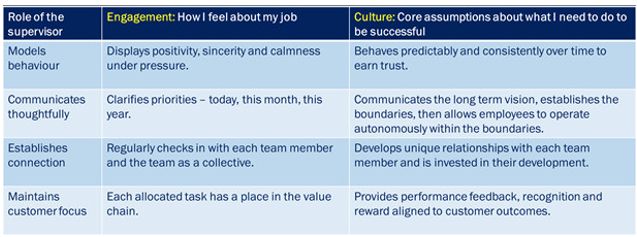
Employee engagement & culture – know the difference to be the difference
Employee engagement and organisational culture are different things. Whilst most of us believe that we know this, few of us are able to describe the differences and fewer still can apply strategies to achieve a lift in one or the other.
What I have observed after two decades working in this field is that front line supervisors have a much better natural instinct with regard to employee engagement than those higher up in the hierarchy. That is because they spend all day with their people and develop mastery at regulating and influencing the short term emotional climate.
As we rise in the pecking order at work, we begin to take more notice of how systems of work influence outcomes. What leaders become aware of is culture, even if they don’t recognise it as that. That is, they develop deeply held assumptions about what must be done to be successful. The unfortunate trade-off is that as we become more attuned to long term cultural systems, we tend to lose our sensitivity to the short term engagement signals that are everywhere in our workplaces. Some leaders become blind to these signals, as they create seemingly irreconcilable conflicts.
“That report was not good enough! I don’t care how Amy feels, if she is going to turn in work of that standard she won’t have a job at all!”
Through my work with individuals and teams, I have isolated four domains of supervisory focus that have the greatest influence on short and long term outcomes. That is, applied thoughtfully, these supervisory practices have the highest impact on positive emotions (lifting engagement) whilst creating sustainable systems (constructive culture).
1. The supervisor models the right behaviours
Short term: She displays positivity, sincerity and remains calm under pressure. She chooses optimism over pessimism and never resorts to displays of cynicism.
Long term: Her behaviour is predictable and consistent. Employees know what they are going to get each day. Over time trust is built.
2. The supervisor communicates thoughtfully
Short term: Each person knows what is expected of them – today, this week, this month and this year. She communicates in a way that each person knows where they stand about the work that has to be done. Responsibility and accountability are clear. She demonstrates connection to the business dynamics and when priorities change, she swings into action, quickly communicating how this impacts every team member.
Long term: She sells the long term vision through artful story telling. She clarifies the boundaries for the team and permits team members to work autonomously within those boundaries, resisting perfectionism in favour of achievement.
3. The supervisor establishes personal connection
Short term: She checks in with people regularly, taking an active interest in the emotional state of her team and other stakeholders. She regulates the connections between team members, sometimes intervening and sometimes not.
Long term: She avoids the traps of treating everyone equally and being blind to uniqueness and differing capabilities. She demonstrates her awareness to difference by actively investing in team members’ long term development.
4. The supervisor maintains the customer focus
Short term: She ensures that allocated tasks have a place in the customer value chain. Nothing is ever done, “because I said so.” Sometimes the customer value is difficult for team members to understand, but she takes the time to explain.
Long term: The systems of performance feedback, individual and team recognition and rewards are fully aligned to delivering customer value. She understands that achieving this congruence minimises perceptions of favouritism or bias.

Measuring both employee engagement and culture are important practices if an organisation wants to understand its progress in short term emotional management and long term systems thinking.
Engagement and culture need to be addressed simultaneously, but have vastly different maturity cycles. Progress on lifting engagement through the supervisor practices described here can occur relatively quickly. Progress on lifting culture has a much longer maturity cycle.
Celebrating improved engagement through positive survey results has important symbolism. It needs to occur in conjunction with long term system changes that will eventually embed the desired culture. Supervisors need to become skilled at describing why longer term work system changes continue to occur in spite of healthy engagement results, to avoid confusion by team members and can develop into change fatigue.
Changing core assumptions about what success looks and feels like requires systems to cycle through repeatedly and predictably before people fully buy-in. Once supervisors collectively buy-into systems thinking, the wheel of culture change starts to turn.
